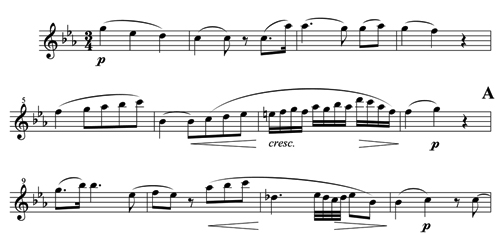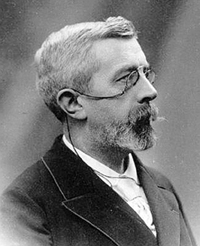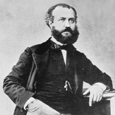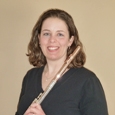The second movement of Petite Symphonie features the flute, making it a favorite of many flutists. The movement is in ternary form, Eb major, and titled Andante cantabile. The flute solo, which begins in measure eight, should be played expressively and soloistically. Essentially, this is a flute solo accompanied by wind octet. While vibrato is important for an expressive solo line, the flutist should keep the vibrato from becoming too slow, wide, or otherwise out of control. The rhythm of the accompaniment serves as a framework within which the flutist can exercise some flexibility.
Introduction
The movement begins with a seven measure introduction with a dotted motive in the horns over the 2nd bassoon pedal point on Bb2. The clarinets and 1st bassoon enter after the second beat in an ascending sequential eighth-note pattern. While the first two of the five-note patterns are marked p with a hairpin crescendo and diminuendo, the performers should continue to shape each group of five notes, slightly increasing the volume of each entrance until the f is reached in measure 5. The last two notes of each of the sequential patterns include a two-note sigh figure (played strong/weak) that occurs on the first beat of each measure, which sets up the sigh figures that occur in the extended flute solo. The accompaniment pattern for the flute solo is played by the clarinets and bassoons beginning in measure 7 and continuing until rehearsal C. The accompaniment pattern is marked pp with an occasional crescendo/diminuendo hairpin.
Flute Solo
The flute solo begins its descending line in measure 8 and continues until rehearsal B where the oboe joins in with the melody. The flutist should practice tapering the last note before each rest by aiming the air stream higher and making the aperture smaller, paying careful attention to pitch on the last note so it is not flat. There should be a clear articulation on the repeated As in measures 9 and 10 as well as in similar places. Forward-tonguing can help with clarity of articulation in this spot.
The solo consists mostly of four-measure phrases with a homophonic texture. Take the time to analyze each phrase in the entire movement to determine how it should be shaped. For example, four measures before rehearsal A the flutist should observe the written crescendo, but might add a slight tenuto to the high D on beat three, two measures before rehearsal A.

The last two quarter notes should diminuendo so that the G is not louder than the F that is on the downbeat. The G-F movement is an example of the two-note sigh figure foreshadowed in the introduction. Analyze each phrase to places for the slight accelerandos or tenutos. In general, follow the usual hierarchy beats within a measure (beat 1, 3, then 2), but refrain from accenting beat one in every measure.
Gounod took care to indicate dynamics throughout the piece, which will help you decide how to shape phrases while maintaining the essence of Gounod’s style.
Several times throughout the second movement, the flutist has thirty-second notes that are essentially a gruppetto that is written out. The first place this occurs is three measures after A.

These should stay relaxed and gentle, even if the fingerings cause the passage to be technically challenging. Some flutists choose to put a very slight tenuto on the first thirty-second note. Be careful not to rush the eighth-notes that follow the thirty-second notes. Although they are written as thirty-second notes, the tempo is not fast, so the turn should be executed in the lyrical style of the solo and not rushed. Remember that the thirty-second notes are embellishments, not the primary notes of the melody. Measure 18 is the first occurrence of the turn into the 3rd beat. Other instances of the turns occur in measure 36, 74, and 76.
Beginning in measure 20, allow the phrase to continue to build tension and expression leading to the climax of the phrase at the downbeat of measure 26. From the climax to the downbeat of rehearsal B, the phrase should relax slightly as the moving line is passed to the bassoons at rehearsal B. During this early statement of the melody, the flutist should be sure to save room in dynamic and expressive range for the apex of the entire movement, which does not occur until measure 76-78.
From rehearsal B to C the flute, first oboe, and first horn split the melody, as if sharing in a conversation. Care should be taken to make the transitions between instruments smooth, keeping the flow of the music moving forward and balancing dynamics and expression with the other instruments that have the melody. Playing the melody with only flute, first oboe, and first horn is helpful in rehearsal to establish continuity of line and to help the other instruments hear the melody. While the melody can push and pull musically, it should stay with the accompaniment and the accompaniment parts should stay together and not rush.
Interestingly, the flutist who performed in the Stockholm Sinfonietta recording, Classics for Chamber Orchestra, Vol. 2, chose to take the measure before and after B and the measure before and after G up an octave. That octave displacement, however, does not seem to be common. There is also no indication in the score that suggests that practice.
Middle Section
Rehearsal letter C features the first clarinet and first bassoon in an ornamented version of the opening phrase that functions as the beginning of the middle section of the movement. The horn has a different repetitive rhythmic motive and the bassoon continues with a similarly written pedal. The mood of the piece changes, and the music becomes slightly less lyrical. The mood change is announced and enhanced with the articulated notes in the horns. In the passage from C to D the flute plays only brief passages in harmony with the first oboe and first clarinet. Those passages should be practiced with the oboist and clarinetist to ensure good pitch and unified movement.
Four measures before D, as well as two measures later, accurately place the notes by listening carefully and matching style and note length with the eighth notes in the clarinet, horn, and first bassoon parts. The flute line should be heard, but the melody is in the first oboe. You should use minimal vibrato and not be more expressive than the melody. Avoid holding the eighth note that occurs three measures before letter D any longer than indicated so the sixteenth-notes in the first oboe are heard.
The first four measures after D contain a conversation that begins in first clarinet, moves to flute, continues in first bassoon, and finishes back in the flute. A suggestion to help with the phrasing is to think of the clarinetist as asking a question, which the flute answers, then the bassoon asks another question, which the flute also answers. Tracing the contour of the notes in these phrases with a pencil will also help with the musicians visualize the direction of the passage. All parts should listen to the second bassoon for the constant eighth-note pulse to be sure the line maintains its direction. Although the flute, first clarinet, and first bassoon are marked p at this spot, the flutist should be sure the melody can be heard over the accompaniment.
Starting eight measures before E, Gounod begins to set up the return of the opening flute solo. The clarinets, horns, and bassoons have a three-measure passage with sixteenth-notes that crescendo and lead to a quick diminuendo executed by the first oboe, first clarinet, and first bassoon. In measures 60 and 61 the flute has motives that contain large leaps. To help with the clean execution of these leaps, the flutist can fill in the space of the leaps with the chromatic notes that occur in the interval between the two notes. The rhythm should be practiced as written, but the space between the notes should be filled with rapid chromatic notes to lead to the next note in the passage. In these two measures listen to the first oboe, first and second clarinet, and first bassoon for pitch and uniform rhythmic execution.
Return of Flute Solo
Most conductors will ritard just before E to set up the return of the flute solo right at letter E. The solo is exactly like it was at the beginning of the movement until the third measure after rehearsal F when the melody leaps an octave higher than its previous statement and continues to be slightly different through G. The octave displacement allows the flutist to add a bit more passion and intensity to the solo, since the higher register makes the flute line very prominent. The fifth measure after rehearsal F is probably the most difficult technical passage in the second movement.

As mentioned previously lean slightly on the first thirty-second note. Some conductors choose to ritard four measures before rehearsal G, with the downbeat three measures before G a tempo.
Several places in measures 76 through 78 could be the climax for the entire movement. An argument could be made for the apex occurring on the downbeat of measure 76, with the flutist arriving on a high, long note that precedes the last gruppetto of the piece. The peak could also be on the downbeat of measure 77, just after that final gruppetto and just before the diatonically descending line that leads into measure 78. Finally, the high point of the piece could be the downbeat of measure 78, with the aforementioned diatonically descending line leading down to the D. Practice placing the climax at different places and seeing what sounds most musical with your interpretation of the solo.
Two measures before G, allow the sixteenth notes to build to a gradual relaxation on the descending line leading into rehearsal G. The leap of a seventh between the G and Ab can be tricky. For a quick and clean execution of the leap, practice slowly alternating between the G and Ab and gradually increasing speed.
At G, the first oboe and first horn seem to begin a conversation similar to the one at letter D with the first clarinet, flute, and first bassoon. The motives are nearly identical to those at G. This time, however, the flute seems to kindly announce the end of the conversation, which leads into the end of the piece.
Five measures before the end, a series of ascending staccato sixteenth notes occurs in the first clarinet, then first oboe, and finally in the flute. The clarinet line is p, the oboe line has a crescendo, and the flute line has both a diminuendo and a ritard, so besides listening to each other for note lengths and style, the musicians must observe the individual dynamics assigned to each part. Prior to playing the sixteenth notes, take an adequate breath to sustain the high Eb with a light, shimmery vibrato and good intonation at a pp dynamic. While all of the other instruments in the ensemble have alternating eighth notes and eighth rests to fill the penultimate measure, the flute holds an Eb into the last measure.
Consistent attention to tone, pitch, and vibrato, in conjunction with expressive and musical playing will create a successful performance of this work. Gounod’s Petite Symphonie has been recorded by many flutists and you should listen to as many recordings as possible to become familiar with this gem in the chamber wind repertoire.
A Brief History
 The Petite Symphonie by Charles François Gounod was written for Paul Taffanel’s Société de musique de chambre pour instruments à vent, which Taffanel (pictured left) formed in Paris in 1878 with the goals of raising performance standards, raising public awareness, and increasing the repertoire for this instrumentation. The instrumentation for the group was that of the classical Harmoniemusik of Mozart’s time (pairs of oboes, clarinets, bassoons, and horns), but with the inclusion of flute and piano. At this time, typical chamber music included strings, but Taffanel sought to create an instrumental ensemble of winds.
The Petite Symphonie by Charles François Gounod was written for Paul Taffanel’s Société de musique de chambre pour instruments à vent, which Taffanel (pictured left) formed in Paris in 1878 with the goals of raising performance standards, raising public awareness, and increasing the repertoire for this instrumentation. The instrumentation for the group was that of the classical Harmoniemusik of Mozart’s time (pairs of oboes, clarinets, bassoons, and horns), but with the inclusion of flute and piano. At this time, typical chamber music included strings, but Taffanel sought to create an instrumental ensemble of winds.
Charles Gounod’s Petite Symphonie was premiered by Taffanel’s Society on April 30, 1885. It was scored for pairs of oboes, clarinets, bassoons, and horns plus flute. The Petite Symphonie has become a standard work in the chamber wind repertoire, but Gounod composed it more as a trifle of a work – a favor for his friend Taffanel. In his book, Gounod, James Harding says that Gounod would “doubtless have been shocked had he known that this unambitious piece was to survive long after his sacred ‘frescoes’ were dead.” While composing the Petite Symphonie, Gounod was also working on the premiere of his major oratorio, Mors et vita.
In the Petite Symphonie, Gounod returned to his youthful style of composition, reminiscent of the two symphonies written thirty years earlier. Some musicians today claim Gounod’s writing to be out of style or pompous, but during Gounod’s time, he was considered to have a fertile and original imagination. Gounod clearly had Taffanel in mind as he composed the flute part, especially with the beautiful flute solo in the Andante. While the flute part in the second movement is substantial, Gounod gave many of the nine players the chance to shine.
Some people believe that Gounod wrote the oboe II part with Auguste Sautet in mind. Sautet was the only member of the ensemble who did not receive a Premier Prix, and some believe that he was a valued benefactor, but an inadequate performer. A quick perusal of the score reveals that the oboe II part is considerably less substantial than any of the other eight parts.
A free score of this work may be downloaded at: http://imslp.org/wiki/Petite_symphonie_(Gounod,_Charles)
References
Blakeman, Edward. Taffanel: Genius of the Flute. New York: Oxford University Press, 2005.
Harding, James. Gounod. New York: Stein and Day, 1973.
Mari, Pierrette. “Gounod (1818-1893): Analyse de ‘La Petite Symphonie.’” L’éducation musicale 48 (June/July 1993): 5-7.
University of North Florida Chamber Winds Program Notes. http://www.unf.edu/coas/music/wind/chamber/
chwindsnotes.pdf. Accessed (29 January 2008).
Wedin, Jan-Olav (conductor). Classics for Chamber Orchestra, Vol. 2. BIS-CD-186. Accessed on Naxos, February 11, 2008.






